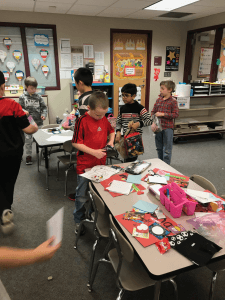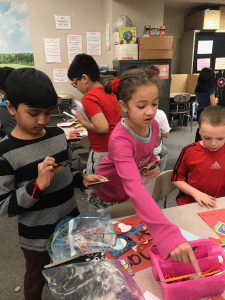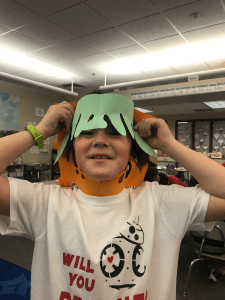Posted by kavery508 | Posted in Uncategorized | Posted on February 25, 2019
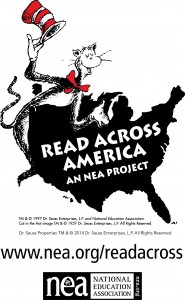 Read Across America Day is coming! This annual nationwide event is held the first week of March in honor of local author Dr. Suess’s birthday. School across the country will welcome community readers into classrooms to read aloud and share the importance of reading in their lives! This year’s theme book is Dr. Seuss’ Happy Birthday to You! which you can watch and read along to here: https://www.youtube.com/watch?v=bwnvgrJVSFw (source: Kids Play and Learn at Youtube.com).
Read Across America Day is coming! This annual nationwide event is held the first week of March in honor of local author Dr. Suess’s birthday. School across the country will welcome community readers into classrooms to read aloud and share the importance of reading in their lives! This year’s theme book is Dr. Seuss’ Happy Birthday to You! which you can watch and read along to here: https://www.youtube.com/watch?v=bwnvgrJVSFw (source: Kids Play and Learn at Youtube.com).
 As we continue our work with finding the main idea in nonfiction texts, students are taking ever more responsibility for finding keywords and creating statements that relate back to the heading and title. As an example, the picture below is from an online text (from Epic, an excellent source for student eBooks though not free). The words that are most important are owner, Mt. Vernon, and Martha. By stringing them together, we get the main idea of the page, e.g. “Washington became the owner of Mt. Vernon and lived there with his wife, Martha.” Helping kids focus in on the big idea is great to do whenever they read at home, too.
As we continue our work with finding the main idea in nonfiction texts, students are taking ever more responsibility for finding keywords and creating statements that relate back to the heading and title. As an example, the picture below is from an online text (from Epic, an excellent source for student eBooks though not free). The words that are most important are owner, Mt. Vernon, and Martha. By stringing them together, we get the main idea of the page, e.g. “Washington became the owner of Mt. Vernon and lived there with his wife, Martha.” Helping kids focus in on the big idea is great to do whenever they read at home, too.
 Our next area of study in math involves understanding and using money. Besides identifying coins/bills and their amounts, students should be able to combine various amounts of both. Consider this example:
Our next area of study in math involves understanding and using money. Besides identifying coins/bills and their amounts, students should be able to combine various amounts of both. Consider this example:
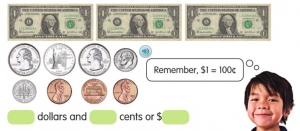 Notice how students can best solve this by starting with the larger amounts and using counting on/adding on. Students will also learn to write in dollars-and-cents notation ($1.25) and with words: one dollar twenty five cents. Students will also learn to compare 2 or more amounts of money. This can get tricky if students are still learning coin values and totaling. For example, 7 coins does not make an amount greater than 2 coins if we’re comparing 7 pennies and 2 quarters.
Notice how students can best solve this by starting with the larger amounts and using counting on/adding on. Students will also learn to write in dollars-and-cents notation ($1.25) and with words: one dollar twenty five cents. Students will also learn to compare 2 or more amounts of money. This can get tricky if students are still learning coin values and totaling. For example, 7 coins does not make an amount greater than 2 coins if we’re comparing 7 pennies and 2 quarters.
For help with homework, see the resources section of your child’s math homework folder where you will find a variety of pages on everything from coins and counting to vocabulary. If you’re following in the eBook, this is Chapter 11. Although many of us pay for things with cards instead of cash, be on the lookout for opportunities to teach your child to total amounts of coins and bills and to estimate 1) if there is enough to buy something and 2) about how much change is due!
Singing is a great way to memorize new skills! Readeez has put out a truly fantastic collection of learning songs. Here’s one of our favorites in class. You can find others (dimes, nickels, quarters, and much more) at Youtube.com and at the Readeez site.
 We have become experts at observing and identifying weather, clouds, and temperature these past two months to help us answer the question, How does weather change day to day and over time? As part of data collection and analysis, students will be evaluating graphs (pie chart, bar graph, area graph) to select the best format for presenting their data collected on daily temperature. They will then enter data and create their graphs using online software at http://nces.ed.gov/nceskids/createagraph/. Finally, they will analyze the data using graphs to look for trends and anomalies, and to draw conclusions. Try the graphing software yourself using any data from home (homework minutes each night; minutes spent getting ready for bed; etc.). The results are really cool!
We have become experts at observing and identifying weather, clouds, and temperature these past two months to help us answer the question, How does weather change day to day and over time? As part of data collection and analysis, students will be evaluating graphs (pie chart, bar graph, area graph) to select the best format for presenting their data collected on daily temperature. They will then enter data and create their graphs using online software at http://nces.ed.gov/nceskids/createagraph/. Finally, they will analyze the data using graphs to look for trends and anomalies, and to draw conclusions. Try the graphing software yourself using any data from home (homework minutes each night; minutes spent getting ready for bed; etc.). The results are really cool!


